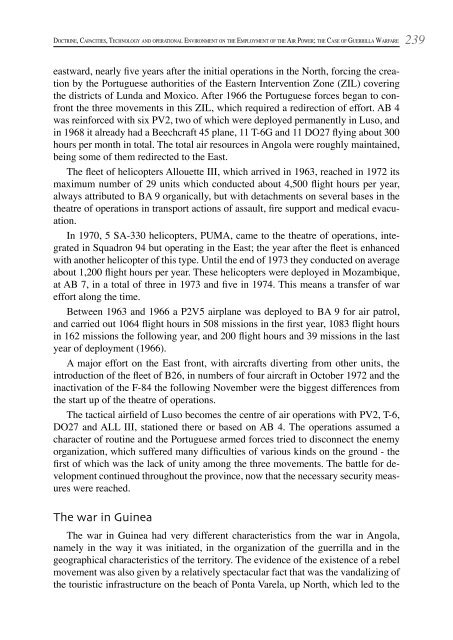National Experiences - British Commission for Military History
National Experiences - British Commission for Military History
National Experiences - British Commission for Military History
You also want an ePaper? Increase the reach of your titles
YUMPU automatically turns print PDFs into web optimized ePapers that Google loves.
do C t r i n e, Ca pa C i t i e s, te C H n o l o g y a n d o p e r at i o n a l en v i r o n m e n t o n t H e em p l o y m e n t o f t H e air po w e r ; t H e Ca s e o f guerrilla wa r fa r e 239<br />
eastward, nearly five years after the initial operations in the North, <strong>for</strong>cing the creation<br />
by the Portuguese authorities of the Eastern Intervention Zone (ZIL) covering<br />
the districts of Lunda and Moxico. After 1966 the Portuguese <strong>for</strong>ces began to confront<br />
the three movements in this ZIL, which required a redirection of ef<strong>for</strong>t. AB 4<br />
was rein<strong>for</strong>ced with six PV2, two of which were deployed permanently in Luso, and<br />
in 1968 it already had a Beechcraft 45 plane, 11 T-6G and 11 DO27 flying about 300<br />
hours per month in total. The total air resources in Angola were roughly maintained,<br />
being some of them redirected to the East.<br />
The fleet of helicopters Allouette III, which arrived in 1963, reached in 1972 its<br />
maximum number of 29 units which conducted about 4,500 flight hours per year,<br />
always attributed to BA 9 organically, but with detachments on several bases in the<br />
theatre of operations in transport actions of assault, fire support and medical evacuation.<br />
In 1970, 5 SA-330 helicopters, PUMA, came to the theatre of operations, integrated<br />
in Squadron 94 but operating in the East; the year after the fleet is enhanced<br />
with another helicopter of this type. Until the end of 1973 they conducted on average<br />
about 1,200 flight hours per year. These helicopters were deployed in Mozambique,<br />
at AB 7, in a total of three in 1973 and five in 1974. This means a transfer of war<br />
ef<strong>for</strong>t along the time.<br />
Between 1963 and 1966 a P2V5 airplane was deployed to BA 9 <strong>for</strong> air patrol,<br />
and carried out 1064 flight hours in 508 missions in the first year, 1083 flight hours<br />
in 162 missions the following year, and 200 flight hours and 39 missions in the last<br />
year of deployment (1966).<br />
A major ef<strong>for</strong>t on the East front, with aircrafts diverting from other units, the<br />
introduction of the fleet of B26, in numbers of four aircraft in October 1972 and the<br />
inactivation of the F-84 the following November were the biggest differences from<br />
the start up of the theatre of operations.<br />
The tactical airfield of Luso becomes the centre of air operations with PV2, T-6,<br />
DO27 and ALL III, stationed there or based on AB 4. The operations assumed a<br />
character of routine and the Portuguese armed <strong>for</strong>ces tried to disconnect the enemy<br />
organization, which suffered many difficulties of various kinds on the ground - the<br />
first of which was the lack of unity among the three movements. The battle <strong>for</strong> development<br />
continued throughout the province, now that the necessary security measures<br />
were reached.<br />
The war in Guinea<br />
The war in Guinea had very different characteristics from the war in Angola,<br />
namely in the way it was initiated, in the organization of the guerrilla and in the<br />
geographical characteristics of the territory. The evidence of the existence of a rebel<br />
movement was also given by a relatively spectacular fact that was the vandalizing of<br />
the touristic infrastructure on the beach of Ponta Varela, up North, which led to the



